April 2023
- English
- 日本語
Plump and Rich Hiroshima Oysters
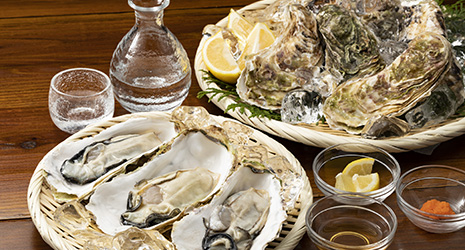
Hiroshima oysters served raw on the shell with dipping sauces and sake (serving suggestion) 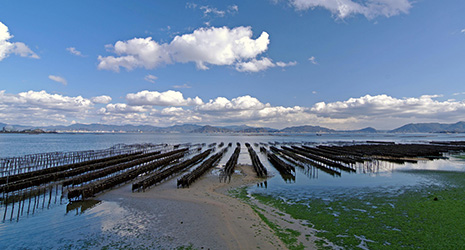
Oyster shelves in Hiroshima Bay

Fresh oysters on the grill 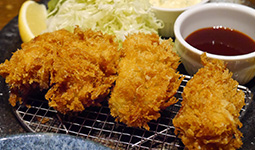
Deep-fried oysters 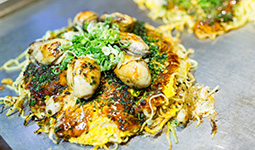
Okonomiyaki pancake served with grilled oysters 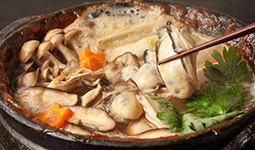
Oyster hot pot

Oysters are known as the “milk of the sea.” Hiroshima produces approximately 60 percent of Japan’s oysters, and they are appreciated for their plump flesh and rich flavor.

Hiroshima oysters are distinguished by their plump flesh, firmness, distinct aroma of the sea, and rich flavor. Hiroshima produces some 20,000 tons of oysters each year, accounting for around 60 percent of Japan’s total oyster production. The waters of the Ota River and its tributaries that flow through Hiroshima City into Hiroshima Bay are rich in nutrient salt* and plankton, creating ideal conditions for oyster cultivation. Many oyster racks can be seen floating in the calm waters of Hiroshima Bay, shielded from the open sea by the headland and islands.
The discovery of oyster shells in shell middens** dating back more than 2,000 years tells us that people had been consuming wild oysters from Hiroshima Bay since ancient times. While oyster farming is said to have begun in the 17th century, in Hiroshima its growth dates from the period following World War II, when oyster racks came into widespread use.

Traditionally, the oyster harvest season runs from October through May in Hiroshima Prefecture, with the height of the season for fresh shipments occurring between November and March. From April, most oysters produced are processed and frozen, and fresh oysters become increasingly scarce.
Recently, however, fresh oysters have become available even in the summer season. Oysters cultivated in Hiroshima Prefecture are mostly magaki (true oysters). However, magaki use up all of their nutrients from the rainy season through summer in order to spawn, at which point they become translucent and their flesh is referred to as mizugaki (water oyster). Mizugaki were not shipped during the summer months because they were not considered tasty. But the arrival of Kaki Komachi (Oyster Komachi), a non-spawning variety of oyster developed by Hiroshima Prefecture, has made shipments of oysters possible even during the summer season. As a result, fresh oysters can be found on some restaurant menus beyond April and even in summer.

Hiroshima Prefecture is also one of Japan’s leading lemon producing regions, accounting for more than 40 percent of production.*** A great way to enjoy Hiroshima oyster cuisine is with a squeeze of Hiroshima lemon. They are also delicious when paired with Saijo sake, another one of Hiroshima’s specialties (see here).
“Oysters from Hiroshima are distinctive for their characteristic oyster-like sea aroma and robust flavor,” says Watanabe Yuzo, Managing Director of the Hiroshima Federation of Japan Fisheries Co-operative Association. Oysters flourish in Hiroshima Bay due to the abundance of plankton which provide them with nutrients, and their flesh becomes firm and plump as a result of an accumulation of umami sources such as glycogen.
As well as being consumed raw, oysters are cooked in a variety of ways, including being baked and deep-fried, and as an ingredient in a hot-pot or takikomi gohan (dishes cooked together with rice). The distinctive aroma of oysters enhances the flavor of a dish in a way that no other ingredient can.

“When cooked in their shells on a mesh grill, the juices ooze into the shells. The oyster flesh and juices combine in the mouth to produce a characteristic oyster flavor that is simple yet has depth,” says Watanabe. “An increasing number of restaurants are also serving oysters as an ingredient in okonomiyaki****, another of Hiroshima’s specialties, so you can enjoy these two Hiroshima specialties at once.”

In October 2021, Hiroshima Prefecture designated Mitsu Bay in Higashi-Hiroshima City adjacent to Hiroshima City as an EU export production zone. In January 2023, the area was awarded HACCP (Hazard Analysis and Critical Control Point) certification, an international standard for food sanitation control, by the Ministry of Agriculture, Forestry and Fisheries. Then February 2023 saw the first export of Japanese oysters to the EU. Oysters that have been frozen in their shells can be consumed raw once they have been thawed. While there are many oyster-producing regions around the world, Hiroshima’s oysters were highly evaluated for their generous flesh and richness of flavor at business negotiations held in Europe in 2022, and the shipment of Japanese oysters to the EU was a source of great pride and high expectations.
It is timely that the G7 Summit is due to take place in Hiroshima in May of this year. Hiroshima oysters are now known around the world for their exceptional flavor and the day may not be too far off when people travel to Hiroshima just to sample them for themselves.
* Generic term for minerals that dissolve in seawater such as silicate, phosphate, oxalate, and nitrite, that nourish phytoplankton, seaweed, and other organisms. Also referred to as nutritive salts.
** Mounds of accumulated remains of the shellfish eaten by people in ancient times.
*** In 2018, 5,528 tons of domestically produced lemons were grown and shipped from 21 prefectures, including Hiroshima Prefecture (42 percent), Ehime Prefecture (31 percent), and Wakayama Prefecture (10 percent).
**** A wheat flour-based dish topped with ingredients such as squid, pork, and cabbage, cooked on an iron griddle and seasoned with sauce or other condiments. Osaka-style okonomiyaki and Hiroshima-style okonomiyaki are the best known.

